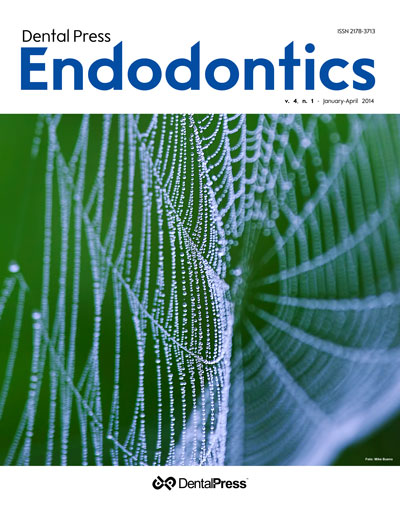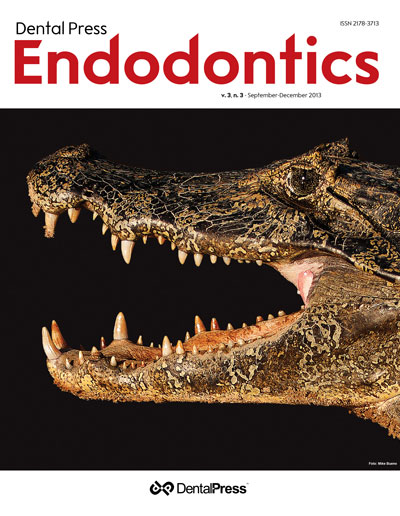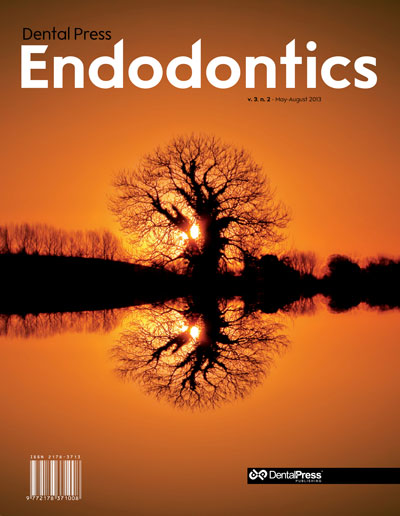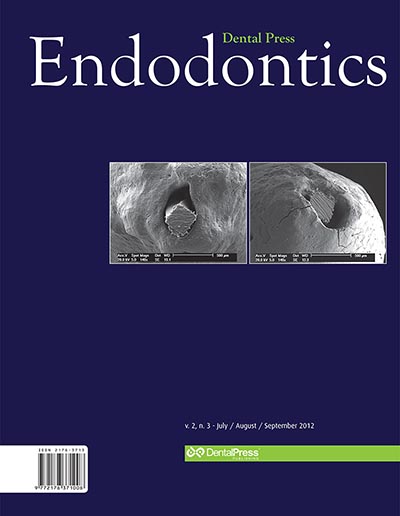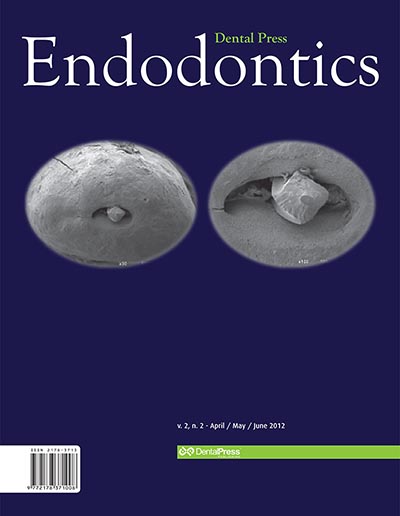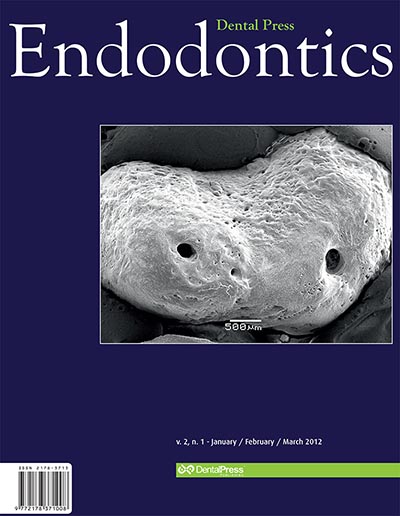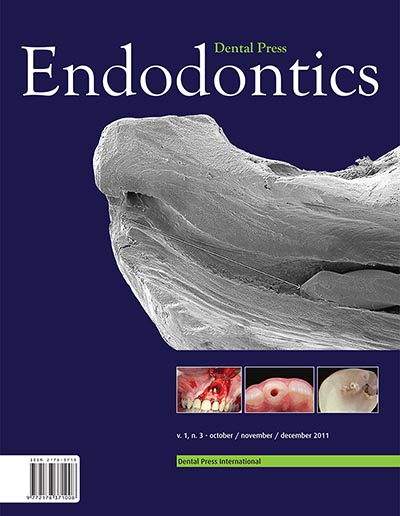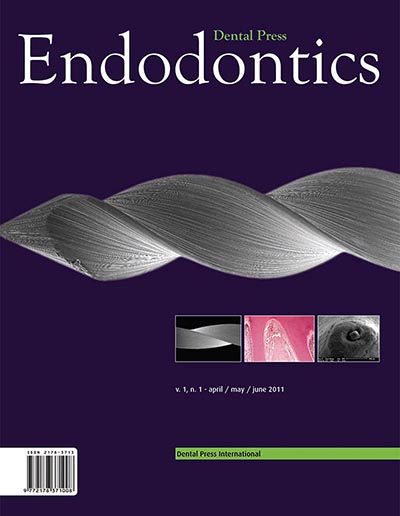v. 01, no. 3
Dental Press Endodontics – ISSN 2178-3713
Dental Press Endod.
v. 01, no. 3
October / November / December
2011
Editorial
Human Resources in Odontology
3 3
Any discussion involving quality control in health, especially human resources, should be discussed with caution, since it relates to the formation of an individual with skills to care for a human being. Qualities and guidance of human services must be constantly reassessed. The differences are clearly observed in levels of complexity for individuals seeking a higher education – of those in charge and of necessary content to constitute a good dentist, a distinguished expert, a real master and a wonderful doctor. Examples should be provided to educate the whole person; examples of life, dignity, nature, and not just a human resource to work in the health field.
For some time the educational project had been flagged as a risk factor that could affect the quality of education. Definitely, a good educational project is important to the process. However, the pedagogical project alone, out of prepared people to run it, has the risk of being inefficient. As time passed, many projects were well structured, reformulated, used and canceled. Many changes in the way of life of globalized human were also tried and experienced. The feeling is that life is easier now, more accessible to different strata. However, a profound, effective and fast improvement is urgent in this professional who is being formed.
It is unacceptable to live and accept the lack of rigor in evaluations, at any academic level. It is common to hear that the assessments are complex, but it should be processed as quality control. It is common to witness that there shouldn’t be failures, but there are disqualified individuals being approved to perform procedures that can affect the quality of life of others. It is understood that a group of teachers in some variations are common – such as ages, backgrounds, experiences, skills, personal balance and moral integrity. Some show skills for management, others for teaching, research, extension, etc. It is common on various specialties or parts that form a health profession an overzealous and trends in some areas. One caution that should be taken and the challenge is showing to the leaders, or those who are ahead of the educational process of the institution the need of knowing the set, before determining the way that operators should follow. There are constant mistakes in academic meetings.
It has been pointed out that the Brazilian dentistry is one of the best in the world, and that professionals have differentiated skills. No doubt, the professionals who has represented Brazil internationally, thanks to the efforts, training, dedication to teaching, research and own abilities, has earned their evidence. However, we know that is not the largest number of professionals who have been highlighted, and that, in order to have this statement as true, there must be changes in attitudes, in order to improve, update increasingly, leaving aside personal positions and mediocrities who can still be observed among some teachers. Thanks to the idealism of some colleagues, the value of undergraduate research has caught attention, since the beginning of the career, to the fact that the construction of knowledge is essential, and that science and technology are key targets for the success of human resources to be formed for society.
Therefore, the teaching factory – laboratory of knowledge – deserves to be treasured. The perception is that you need to honestly disclose that human resources are being prepared and that are eligible for the office of health and there is no doubt about this assertion. The change to improve the quality of human resources to be formed involving joint action and not isolated, with effective participation of administrators, teachers, students, support staff, backed by predisposition, exercise, and interest.
Endo in Endo
The concept of Tooth Resorption and why it does not induce pain or necrotic pulp
11 16
The concept of tooth resorption does not appear to be uniform in different scholarly studies, from a simple monograph to research texts published in the literature to dissertations. This article aims to contribute to the conceptual standardization of this important pathological process, which involves virtually all dental specialties, especially endodontics.
Original articles
A comparison of clinical, histological and radiographic findings in periapical radiolucid lesions
Radiography. Diagnosis. Oral pathology.
17 21
Objective: Pulpal inflammation and necrosis can eventually cause periradicular diseases or apical pathologies, which are clinical and radiographically suggestive of an inflammatory sequel. Thus, the objective os this study is to compare the degree of agreement between the diagnosis of teeth with periapical lesions and histopathological analysis.
Methodology: Fifty nine patients with surgical indication (teeth with lesions) were selected. In the radiographic analysis the appearance was observed, the size of the lesion was measured and a diagnosis hypothesis was suggested. Histological sections were examined under the microscope and the specimens classified as granuloma, cyst or chronic abscess.
Results: The results showed 40.7% of concordance between the clinical-radiographic and histological diagnosis. According to histological analysis, 35.6% of the cases were granuloma, the cystic lesions corresponded to 59.03% and 5.09% were chronic abscesses.
Conclusion: Thus, through only clinical and radiographic examination is not possible to confirm the diagnosis of lesions, because even images considered as cysts can be resulted from abscesses or granuloma, whereas the opposite may also occur.
Comparison of the success rates of four anesthetic solutions for inferior alveolar nerve block in patients with irreversible pulpitis. A prospective, randomized, double-blind study
Endodontics. Pulpitis. Anesthesia. Local.
22 26
Introduction: This study compared the efficacy of four anesthetic solutions for inferior alveolar nerve block (IANB) in patients with irreversible pulpitis.
Material and Methods: This prospective, randomized, double-blind study included 60 adult volunteers. The patients were randomly divided into four groups of 15 and received conventional IANB as follows: Group ART - 2 cartridges of 4% articaine with 1:100,000 epinephrine; Group LID - 2 cartridges of 2% lidocaine with 1:100,000 epinephrine; Group PRI - 2 cartridges of 3% prilocaine with 0.03 IU felypressin; and Group MEP - 2 cartridges of 2% mepivacaine with 1:100,000 epinephrine. Access was begun 10 minutes after IANB, and patients were instructed to rate any pain felt during the endodontic procedure. The success of IANB was defined as access and instrumentation of root canals with no pain. If the patient felt any pain, the treatment was discontinued immediately and the anesthetic procedure was classified as unsuccessful.
Results: The chi-square test was used to analyze results (α = 5%). There was no significant difference (p > 0.05) in the efficacy of IANB between the ART (53.33%), PRI (46.66%), and MEP (53.33%) groups. However, the success rate in the LID group was statistically lower (20%) than in the other groups (p < 0.05).
Conclusion: None of the anesthetic solutions had an acceptable success rate for IANB in patients with irreversible pulpitis. The solution of 2% lidocaine with 1:100,000 epinephrine had the worst rate when compared to the other groups.
Evaluation of calcium hydroxide dressing for short term prevention of coronal leakage
Coronal leakage. Calcium hydroxide. Dressing. Healing process.
27 33
Objective: The aim of this in vivo study was to evaluate the influence of coronal leakage on the apical dog’s teeth healing, which were dressed with calcium hydroxide and kept or not in contact with oral environment.
Material and Methods: After biomechanical preparation and filling with calcium hydroxide/saline paste, twenty six root canals were randomly divided into two experimental groups: Group 1 - coronally sealed with temporary restorative material; Group 2 - coronally unsealed. The animals were sacrified after 7 days and the specimens were prepared for histological analysis.
Results: In both groups the results were similar. Inflammatory cells were not present in the apical tissue or in the cementum. Besides, it was observed necrosis in the coronary third surface of the pulp stump and microorganisms were noted just in contact with debris, which were present in the specimens pulp chamber without sealing but not in the root canal.
Conclusion: It was concluded that the calcium hydroxide used as dressing prevented the contamination of the root canal and keeps its mechanism in the apical tissues even under defective sealing in a period of at least 7 days.
Influence of root canal irrigants on compressive strength and surface morphology of gray MTA Angelus®
Endodontics. Compressive strength. Microscopy.
34 40
Objective: The present study aims to evaluate the influence of root-canal irrigants in the compressive strength and surface morphological characteristics of gray MTA Angelus using scanning electron microscopy (SEM).
Methods: The MTA was mixed according to the manu instructions from manufacturer and packed incrementally into silicone cylindrical molds with an internal diameter of 2 mm and a height of 4 mm. After the initial setting, 30 samples were randomly divided into 3 groups (n=10). In Group C (control) the samples were immersed in a saline solution, in Group MC the samples were immersed in a 2.5% sodium hypochlorite solution and in Group MH the samples were immersed in a 2% chlorhexidine digluconate solution, all remaining for 1 hour. After rinsed, the compressive strength was measured in an Instron 4410 test machine with a crosshead speed of 0.5 mm / min. The surface morphological characteristics were determined by scanning electron microscopy (SEM). The statistical significance in compressive strength was evaluated by one-way analysis of variance (α=0,05).
Results: The average compressive strength values (MPa) were 69.24±7.32 (Group C), 64.74±9.21 (Group MC) e 71.15±11.54 (Group MH), with no significant difference. The results of SEM had demonstrated that the microstructures from group C and MH were crystalline, composed of cubic crystals. A granular structure, in which crystals had not formed, was observed in the Group MC.
Conclusion: The immersion in root-canal irrigants did not affect the compressive strength of MTA, with changes only in surface morphological characteristics. Further studies are needed to determine the clinical relevance of this crystal structure.
Accuracy of the Root ZX II using stainless-steel and nickel-titanium files
Tooth apex. Dental instruments. Endodontics.
41 44
Objective: The aim of this in vitro study was to evaluate the accuracy of the Root ZX II electronic apex locator (EAL) using hand stainless-steel file, nickel-titanium hand file and nickel-titanium rotary file.
Methods: Twenty straight single-rooted maxillary central teeth were used. The actual working length (AWL) was measured by inserting a #15 K-file until the file tip was visible at 4x magnification. The file was removed from the canal and its length was measured using a digital caliper. For the electronic measurements, samples were fixed in glass recipients with plastic cover, containing 0.9% saline solution. The measurements were carried out using the Root ZX II and they were performed using a #15 K-file, NiTi hand file and a rotary Mtwo file. The files were attached to the EAL and during their insertion into the root canal the measurements were monitored until the display indicated “zero”. The corresponding values of the difference between the AWL and the electronic measurement were recorded and submitted to ANOVA and Tukey test (α=0.05).
Results: No statistically significant differences (p<0.05) was found among the tested files.
Conclusion: It can be concluded that both stainless steel files and NiTi hand or rotary files are adequate to determine the working length using the Root ZX II.
Evaluation of light filter of portable dark chamber and its influence on radiographic image quality
Dental radiography. Diagnostic imaging. Radiography.
45 50
Introduction: The Ordinance 453 of the Brazilian Ministry of Health recommends processing intraoral radiographic films in opaque portable dark chamber without display and using the temperature x time method. However, the processing using the visual method in dark chambers with acrylic polymer display is still frequent. The aim of this study was to evaluate and compare the filtering capacity of four portable dark chamber (Unemol®, VH®, MPG® and a camera without identification) with the capacity of a conventional dark chamber (control) and check its influence on image quality in different radiographic films (Kodak®: DF-58 Ultra-Speed, E-Speed and IP-21 Insight; and Agfa® Dentus M2).
Methods: The films were exposed with a step wedge of aluminum and a lead plate and processed in Kodak® solutions ready for use in each portable dark chamber and in the conventional dark chamber (control). The films remained three minutes in the developer and at every minute the films were approximated to the display, simulating the clinical condition, followed by intermediate bath and fixing for six minutes. Photodensitometric assessment was made and the data were analyzed by Mann-Whitney and Kruskal-Wallis tests.
Results: The first test showed that in relation to the control group there was no statistically significant differences with the Unemol® chamber when using IP-21 Insight and E-Speed films and the VH® chamber when using IP-21 Insight film. The second test showed a significant statistical difference when comparing one film to each other.
Conclusion: This research suggested that the acrylic display increases the base veiling density, jeopardizing the quality of the radiographic image.
Use of synthetic hydroxiapatite and MTA in periapical surgery: A case report
Periapical diseases. Periapical periodontitis. Periapical tissue.
51 55
Objective: This article aimed to report a case of periradicular surgery in which biomaterials, such as MTA and synthetic hydroxiapatite were used. A periapical radiograph showed an extensive radiolucent area extending from the mesial aspect of the tooth 21 to distal aspect of tooth 22. Apicoectomy was performed and root-end cavities were prepared and restored with MTA as a retrofilling material. Synthetic hydroxiapatite was also used aiming to model the lost bone structure. The enucleated lesion was submitted for histopathological examination. A diagnostic of periapical granuloma was established based on the microscopic analysis. Two years after the periradicular surgery, there were no clinical or radiograph suggestive signs of treatment failbure. Instead, the patient’s follow-up has shown that the case management has been successful as indicated by lesion regression and periodontal repair. Based on this case, we can conclude that the definitive diagnosis of the type of periapical lesion can only be made by a histological examination and apical surgery can be an excellent complementary procedure when endodontic treatment has not yielded healing outcome.
Biocompatibility of the different portions of the content of AH Plus® sealer tubes through subcutaneous implantation
Biocompatible materials. Subcutaneous tissue. Endodontics.
56 64
Objective: Following the ISO/FDI and ANSI/ADA criteria, this study evaluated tissue response to the resinous sealer AH Plus®, analyzing its initial, middle and final tube segments as well as the total mixture of the two pastes that comprises it. This methodology was based on the clinical observation of the differences in consistency, homogeneity and fluidity of this sealer according to which part of the tube is used.
Methods: Two subcutaneous implants were carried out in the dorsal region of 5 guinea pigs (Cavia porcellus) for each portion of the tested sealer and total mixture. The observation periods were 30 and 90 days. The animals were sacrificed and the implants were removed and histologically processed to obtain serial sections which were stained using hematoxylin and eosin.
Results: The histological evaluation using an optical microscope at 20x, 100x, 200x, 400x and 1000x magnifications showed that the sealer induced moderate to severe inflammatory response at 30 days with expressive inflammatory infiltrate, which decreased to moderate to mild response at 90 days, with mild or moderate inflammatory infiltrate. There was no significant difference between the segments of the tube.
Conclusion: This evaluation led to the conclusion that the studied sealer does not present conditions of biocompatibility within the parameters and the experimental conditions adopted and there is no biological difference between the initial, medium and final segments or complete mixture of the two pastes.
Interdisciplinary treatment of an avulsed permanent tooth in patient with incomplete facial growth
Dental trauma. Tooth avulsion. Tooth replantation. Root resorption. Dental implant.
65 70
Introduction: The rehabilitation of patients with dental avulsion history could be complex and difficult to choose. The possibility of rehabilitation with dental implants may be considered when choosing the replantation, due to the possibility of bone tissue maintenance, especially in patients with incomplete facial growth.
Objective: The purpose of this paper is to report a dental avulsion case treated by late tooth replantation, aiming at bone level maintenance for further rehabilitation with dental implant.
Case Report: Male patient, 11 years old, suffered dental trauma during sports practice, resulting in tooth #21 avulsion. The tooth was found after 24 hours. The therapeutic choice was tooth replantation, although the conditions were adverse due to extraoral time (60 hours) and storage medium (dry). The tooth was cleaned, immersed in calcitonin for 15 minutes, and endodontically treated before replantation. Then, a semi-rigid splint was used for 10 days. One year after the replantation a replacement root resorption was radiographically diagnosed. After 7-year follow-up, the root was almost completely reabsorbed, with sufficient bone tissue for insertion of dental implant. The tooth remnant was removed and an immediate dental implant was performed. After 6 months, a ceramic-ceramic crown was confected.
Conclusion: Thus, the importance of avulsed tooth replantation is clear in the maintenance of bone tissue level for dental implant placement and, consequently, reestablishment of function, as of esthetic and phonetic.
Anatomic fiber posts, clinical technique and mechanical benefits – a case report
Tooth wear. Dentistry. Esthetics. Dental. Occlusal Adjustment.
71 78
Introduction: Glass fiber post usage has been extensively studied due to biomechanical benefits, in addition to adhesive capacity, which makes it able to be used in several clinical situations. Studies show that a perfect root canal adaptation is important for restorative properties improvement.
Objective: The aim of this paper is to present a technical sequence of post relining for the restoration of a fractured upper central incisor with wide root canal.
Case report: A 12-year old male patient came to dental school with a fractured upper central incisor, exposing pulpal tissue. After endodontic treatment procedures the selected post could not fit the root canal and a microhybrid composite resin was selected for post relining. After that the post was cemented with a autopolimerizing resin cement and the final restoration completed with the same resin.
Results: The suggested technique resulted on a functional and esthetic rehabilitation with great possibilities of long lasting restoration.
A histological assessment of dentine, after the clinical removal of caries in extracted human teeth
Dental caries. Dentin. Microorganisms. Radiographic exam.
79 87
Introduction: Despite the evolution in the strategies used to prevent and treat dental caries, no consensus exists regarding the relationship among caries depth and bacterial contamination.
Objectives: To analyze the depth of the carious lesion after clinical removal of carious dentin, and assess the presence, location and distribution of microorganisms in the dentinal tubules, in different degrees of the lesion depth.
Methods: 20 carious human premolars were evaluated to determine the relationship among bacterial invasion and clinical carious degree using Brown and Brenn’s bacterial stain. The data were subjected to Pearson’s correlation coefficient.
Results: The correlation between the number of microorganisms found within the different caries degrees was considered slightly positive (r = 0.038). No correlation between the distribution and the location of microorganisms in different caries degrees was verified.
Conclusion: The presence of microorganisms in critical areas, such as the enamel-dentin junction and in the deeper cavity floor suggests the influence of anatomical characteristics on caries pathology
Antibiotic prescription behavior of specialists in endodontics
Antibiotic therapy. Endodontics. Bacterial resistance.
88 93
Introduction: The present study proposed to determine the antibiotic prescription behavior of endodontic specialists regarding antibiotic administration timing, indication and first choice options.
Methodology: A four-question questionnaire was delivered to 105 endodontists in São Paulo state, Brazil. The results were statistically analyzed.
Results: Within the interviewed specialists, 48.5% were male and 51.5% female. Amoxicillin was the first choice antibiotic for 84.7% of professionals. For a scenario of penicillin allergic patients, 47.6% would prescribe clindamycin and 42.8% azithromycin. The great majority (79%) indicates antibiotics administration for a period of 5 to 7 days. Close to one third of interviewed individuals inadequately indicated antibiotic therapy.
Conclusion: The majority of professionals were able to correctly select the antibiotic for non-allergic and penicillin allergic patients, as well as regarding the administration timing. On the other hand, there are still professionals inappropriately applying antibiotic therapies, favoring bacterial resistance.


